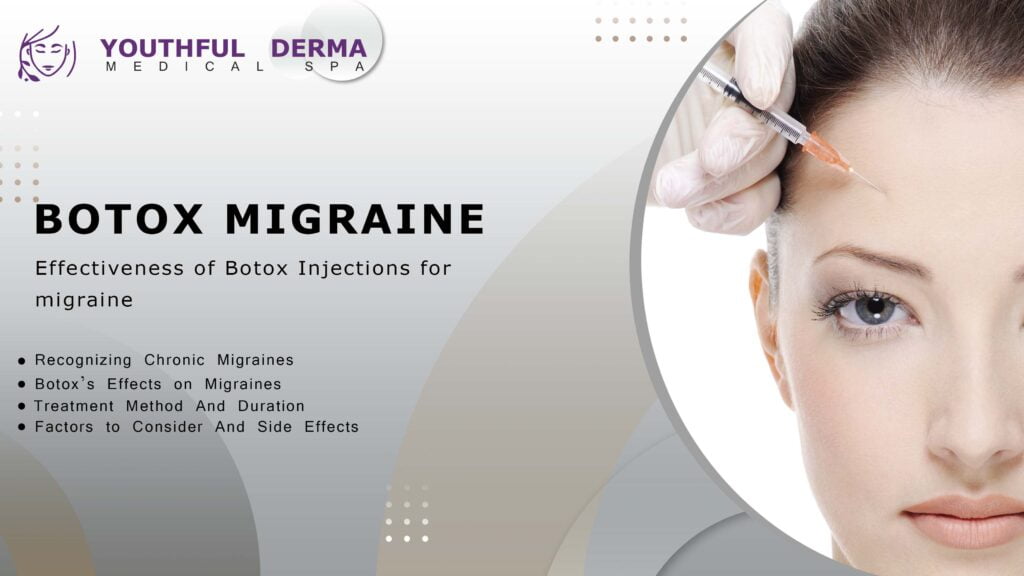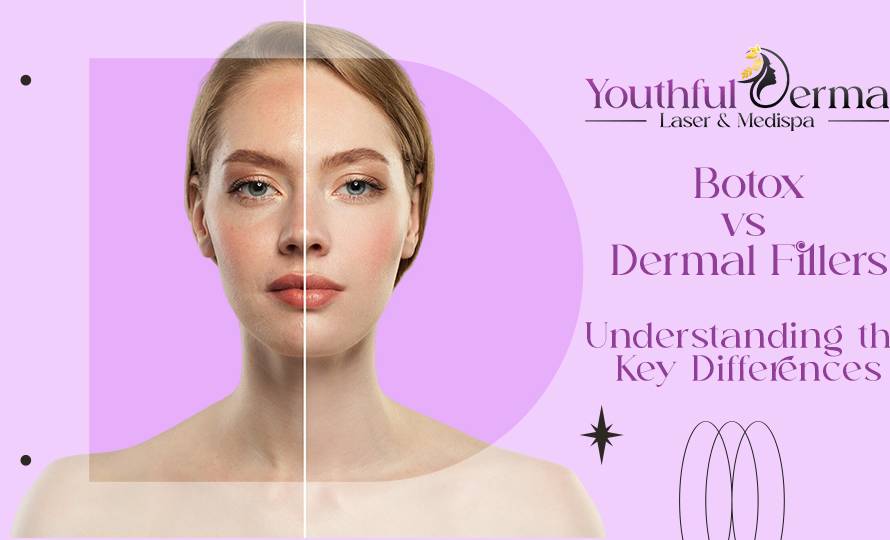Effectiveness of Botox Injections for Migraine – Youthful Derma
According to the most recent data, over 180,000 Botox treatments were carried out in Canada in 2021, though exact statistics may vary. This number demonstrates the nation’s rising need for Botox treatments. The advantages of Botox, including minimal invasiveness, quick recovery, offering a more youthful and rejuvenated appearance attract more and more Canadians. Hence, Botox has become a popular choice for people wishing to enhance their natural beauty worldwide.
Botox injections have become a highly effective treatment for chronic migraines. According to clinical research, Botox can dramatically lessen both the frequency and intensity of migraine attacks. In addition, it helps treat migraines by selectively paralyzing specific muscles in the head and neck region, reducing symptoms, and enhancing patients’ quality of life. People who experience chronic migraines may find some relief and a chance to recover control of their life with the help of this non-invasive technique. This blog examines the effectiveness of Botox as a migraine treatment for those who get migraines.

Recognizing Chronic Migraines
It’s important first to understand chronic migraines to understand how Botox affects migraines. Chronic migraines are characterized by 15 or more migraine days each month, at least eight of which must meet the requirements for a migraine episode. In addition, these migraines frequently feature crippling symptoms such as severe pain, sensitivity to light and sound, nausea, and others.
Botox’s Effects on Migraines
OnabotulinumtoxinA, also referred to as “Botox,” is a pure toxin produced by the bacteria Clostridium botulinum. It works by temporarily blocking the release of the neurotransmitters that cause migraines when injected into particular muscles. The injection sites often target the forehead, temples, and neck, which are migraine-related areas of tension or pain. Botox may help relieve migraines by lowering muscle tension and obstructing nerve signals from reaching the brain.
Scientific Proof and Success Rates
Extensive research and clinical studies have established the efficacy of Botox in treating persistent migraines. A strong proof of Botox’s effectiveness has led regulatory agencies, including Health Canada and the FDA, to approve the drug for treating chronic migraines. According to clinical research, Botox injections can significantly reduce migraine attacks’ frequency, length, and severity. While there are different success rates, many patients report a noticeable improvement in their symptoms, which improves their quality of life.
Treatment Method and Duration
An adept healthcare expert will normally provide a series of Botox injections as part of the treatment for migraines. The treatment typically takes 15 to 20 minutes, and your doctor can conduct it in an office environment. While individual results may vary, most patients need numerous sessions for the best outcomes. It may take a few weeks to detect a decrease in migraine frequency and severity after receiving Botox injections for migraines. Besides this, three months is the typical duration of the effects before a second treatment may be required.
Factors to Consider and Side Effects
Botox is generally very popular, but addressing any risks and side effects with a healthcare provider before receiving treatment is crucial. Botox injections for migraines frequently cause temporary muscle weakness, neck pain, or localized bruising at the injection site. Rarely more serious adverse effects could happen. It’s crucial to get Botox treatments from a licensed doctor who can carefully weigh the advantages and disadvantages particular to your case.
Can Botox treat migraines completely?
No, Botox is not a migraine remedy. When used as a treatment, it may assist those with persistent migraines to experience fewer and milder attacks. Some people get relief using Botox, which temporarily blocks nerve signals and eases the muscle tension brought on by migraines. Botox has temporary effects. Therefore, patients may need more treatments to keep the advantages.
How soon does Botox start to relieve migraines?
Botox injections for migraines don’t work right away. It may take weeks to notice a considerable decrease in migraine frequency and severity, usually two to three medication cycles. Multiple injections are administered with each treatment cycle, and it’s possible that the full advantages of Botox won’t become apparent until after the initial sessions.
Does Botox for migraines include any risks or adverse effects?
When given by a licensed healthcare expert, Botox is generally safe. However, remember to be aware of some possible risks and side effects. Temporary muscle weakness, localized discomfort, bruising, or swelling at the injection sites are typical adverse effects. Rarely, more serious negative effects like breathing or swallowing difficulties, allergic responses, or flu-like symptoms may manifest. You can consult with the experts at Youthful Derma also for further details.
Final Thoughts
People who experience chronic migraines may find Botox a potential therapy choice. It has become a crucial tool in migraine care due to its effectiveness in lowering migraine frequency and intensity, supported by clinical evidence and regulatory approvals. Consult with a healthcare provider before choosing Botox as a migraine treatment so they can offer you individualized advice. Hence, they will help you decide if this action is right for you. Botox could be a valuable option for your comprehensive treatment plan.



